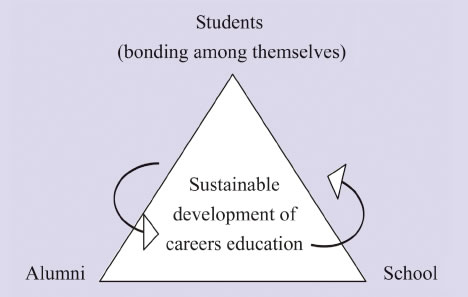Other Learning Experiences is one of the three major components of the Senior Secondary curriculum that complements the core and elective subjects (including Applied Learning courses and other languages) for the whole-person development of students. These experiences include Moral and Civic education, Community Service, Career-related Experiences, Aesthetic Development and Physical Development.
Values constitute the foundation of the attitudes and beliefs that influence one’s behaviour and way of life. They help to form the principles underlying human conduct and critical judgement, and are qualities that learners should develop. Some examples of values are rights and responsibilities, commitment, honesty and national identity. Closely associated with values are attitudes. The latter supports motivation and cognitive functioning, and affects one’s way of reacting to events or situations. Since both values and attitudes significantly affect the way a student learns, they form an important part of the school curriculum.
Its purpose is to provide supplementary information on the secondary school leavers’ participation and specialties during senior secondary years, in addition to their academic performance as reported in the Hong Kong Diploma of Secondary Education, including the assessment results for Applied Learning courses, thus giving a fuller picture of students’ whole-person development.
| Booklet 9 |
Student Guidance on Careers and Further Studies – Exploring the Future |
|
| |
| This is one of a series of 12 booklets in the Senior Secondary Curriculum Guide. Its contents are as follows: |
Contents |
| 9.1 |
Purpose of the Booklet |
| 9.2 |
The Role of Careers Guidance in the Senior Secondary Curriculum |
| 9.3 |
Key Principles of Careers Guidance in the Senior Secondary Curriculum |
| 9.4 |
Self-planning of Students at Different Stages |
| 9.5 |
Fostering Connections between Senior Secondary Curriculum Components |
| 9.6 |
Some Suggested Guidance Activities for Further Studies and Careers |
| Appendices |
| References |
|
| |
| |
| 9.1 Purpose of the Booklet |
| |
 |
To illustrate how careers guidance could play a role in the senior secondary (SS) curriculum |
 |
To demonstrate some good practices in careers education and guidance |
 |
To enhance effectiveness, synergy and sustainability in schools |
| |
| |
| 9.2 The Role of Careers Guidance in the Senior Secondary Curriculum |
| |
| Careers guidance is not new to schools. It plays a significant role in helping students to develop the knowledge and skills needed for making wise choices, manage transitions in learning and move into the workplace. |
| |
| As demonstrated by current best practices in schools, careers guidance should no longer be regarded as merely offering a remedial, advisory service on careers before graduation, but as a broader concept that refers to ‘a totality of experiences’ by which students acquire knowledge and attitudes about self and work, as well as the skills to plan and prepare for a career. |
| |
| Careers guidance, in its broader meaning, usually consists of a range of dimensions that may run across the secondary years. For example: |
 |
Individual student planning |
 |
Understanding self |
 |
Career exploration and career-related experiences |
 |
A guidance programme for further studies |
 |
Remedial and accelerated counselling for individual students. |
| |
| An example of a school plan for careers education and guidance is given in Appendix I for reference. |
| |
| |
| 9.3 Key Principles of Career Guidance in the Senior Secondary Curriculum |
| |
| The emphasis of careers guidance should be placed on empowering students to make informed and responsible choices for themselves. They should not simply be passive receivers. Therefore, the guidance should not be confined to services that provide ‘problem-solving’, ‘tips’ or tactics for S3 and S6 students when they are confronted with the need to make critical career choices. |
| |
| Teachers should encourage students to make their career decisions in accordance with their interests, abilities and personal orientations, apart from examining external factors such as career prospects, subject choices available, constraints and opportunities. |
| |
| Building on their strengths (e.g. class teacher structure, individual learning portfolios), schools could consider promoting individual student planning to encourage individual career goal setting and reflection. In self-planning, students should have the opportunity to develop different life skills (e.g. self-management, time management) which are essential for future life-long learning. |
| |
| Careers guidance should start early at junior secondary levels and should progressively develop students’ understanding of themselves in the context of whole-person development. If appropriate, learning tools could be used to help students to acquire reflective habits of mind as well as ‘developed but yet flexible’ attitude towards the future, in terms of constructing individual hopes. |
| |
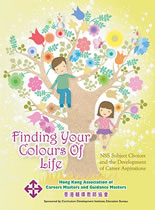 Finding Your Colours of Life : New SS Subject Choices and the Development of Career Aspirations Finding Your Colours of Life : New SS Subject Choices and the Development of Career Aspirations
With the support of the Education Bureau’s (EDB) Partnership Scheme, the Hong Kong Association of Career Masters and Guidance Masters has developed a resource pack to help students at S1 to S3 to make informed decisions about their study choices in the SS curriculum, through understanding of ‘self’ (both strengths and constraints) and the schools’ context (e.g. subject choices offered; career opportunities). It aims to develop reflective habits of mind by encouraging goal setting and the rethinking of goals for further adjustment in the planning loop. The tool emphasises that there is no so-called ‘Wrong’ choice, but students are, nevertheless, encouraged to be responsible for their own informed choices. |
|
| |
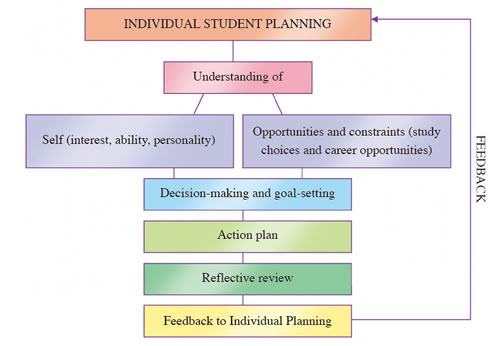 |
http://cd1.edb.hkedcity.net/cd/lwl/ole/ole_articles.asp |
|
|
| |
| Careers guidance is for all students, irrespective of their abilities and orientations. There may be a misconception that students with good academic results (or potential) do not need careers education and guidance. In fact, early preparation and strategic planning make a great difference for everyone in terms of achievement, career choices and future success. |
| |
| Making good use of community resources and partnerships (e.g. parents, alumni, sponsoring bodies and local businesses) is essential in planning quality student activities for careers education and guidance. |
| |
| |
| 9.4 Self-planning of Students at Different Stages |
| |
| The SS curriculum offers a wide range of pathways to cater for different individual needs, abilities and interests. It provides smoother multiple routes to higher education and the workplace so that every student has an opportunity to succeed in life. Students should be encouraged to make informed career decisions before and during their studies at the SS level. |
| |
Figure 9.1 Multiple Pathways towards Life-long Learning |
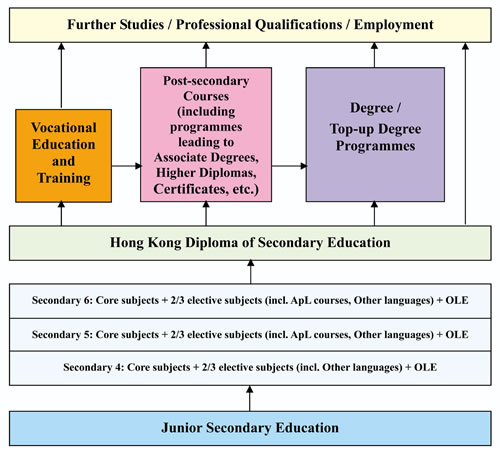 |
| |
| Junior secondary (S1-3) |
| |
| Under the overall aim of whole-person development, the SS curriculum has been specially designed to ensure a reasonable level of broad and balanced coverage of knowledge and skills irrespective of the individual’s elective subject choices. Students should therefore be encouraged to choose their SS elective subjects and/ or Applied Learning (ApL)1 courses in accordance with their interests, potential, orientations and abilities, rather than in relation to certain future careers or university courses. |
| |
| Students should have the opportunity to learn about the SS subjects, including ApL, that are available in their schools before making their subject choices. Activities could be organised to enhance such understanding and empower students to be active, informed decision-makers (e.g. reviewing case studies of former students). |
| |
| With the assistance of teachers, students could identify a list of people (e.g. parents, teachers, friends) who could help them in the decision making process. |
| |
| 1ApL was formerly named “Career-oriented Studies”. Readers may refer to the report “Action for the Future – Career-oriented Studies and the New Senior Secondary Academic Structure for Special Schools” (EMB, 2006) for details. |
| |
| Senior secondary (S4-6) |
| |
| During their SS studies, students should be provided with opportunities to understand and discuss flexible career routes and should be encouraged to list factors (e.g. opportunities and limitations) that might affect their progress along certain pathways. |
| |
| Students should be encouraged to use different tools (e.g. self-assessment questionnaires) to help to identify and set short, medium and long-term goals, as well as career and learning targets. |
| |
| Students should be given the opportunity to understand the complementary and supplementary nature of ApL so as to make informed choices in choosing their elective subjects for their SS studies, which should include but not be limited to the understanding that: |
| |
 |
the context of each ApL course is based on a cluster of trades or industries which reflect the social, economic and technological needs of local society and global trends and is close to students’ daily lives; |
 |
the curriculum of ApL, through which students acquire a helicopter’s view of the opportunities and risks of related trades and industries, can help them to explore their direction for life-long learning while at the same time to pursue in-depth studies in a selected area in which they can develop their transferable skills such as foundation skills, thinking skills, people skills, as well as values and attitudes; and |
 |
the authentic contexts of ApL courses can also complement students’ studies in other subjects and contribute to their whole-person development. For instance, students who aspire towards studies/ careers in creative industries may choose Visual Arts, History, and an ApL Creative Studies course. Such a combination can provide students with disciplined underpinnings and historical and cultural perspectives as well as a taste of the particular industries and the related opportunities and risks. |
| |
| To prepare students for making informed choices of ApL courses as part of their SS studies, ’taster’ programmes selected from the range of courses within the six ApL areas of studies2 could be offered as part of the Other Learning Experiences (OLE) programmes prior to students choosing their SS elective subjects. |
| |
| Rather than accepting only ‘top-down’ advice by careers teachers, students should be encouraged to take charge of their own career plans and enquiries. They should develop the skills to make use of a range of information sources (e.g. university admission criteria, Institute of Vocational Education courses, job search materials) and devise practical plans to equip themselves. |
| |
| Life-long learning is at the heart of careers guidance. Students should understand that there are usually no ‘Right’ or ‘Wrong’ choices in careers. In this rapidly changing society, a person may be involved in a career of many and diverse jobs and the key for life success will depend on both a life-long commitment to learning and the capability to plan and cope with transition and change. |
| |
| 2The six areas of studies under ApL are Creative Studies; Media and Communication; Business, Management and Law; Services; Applied Science; as well as Engineering and Production. |
| |
| |
| 9.5 Fostering Connections between Senior Secondary Curriculum Components |
| |
| In schools, effective careers guidance should not be viewed as a totally separate entity but should be connected flexibly with other components in the SS curriculum such as OLE and subject learning. It is often linked with the development of Student Learning Profile (SLP). |
| |
| Collaboration and co-ordination among committees and teachers should be encouraged to enhance synergy and to avoid overlaps and repetitions of goals. |
| |
Example: Connected Leadership – Helping Students to Plan Their Future |
| |
| In preparation for the New Academic Structure, School A reviewed what was in place for their students to help them to plan for their future. They found many overlapping aims among different curriculum components, such as career-related experiences, careers guidance and SLP. Panel heads, deputy heads and team leaders conducted a mapping exercise to audit existing aims and identify ‘gaps’ in the promotion of reflection and self-planning among students. Beyond formal structures, networking among teams was encouraged and professional sharing sessions were organised regularly for the alignment and celebration of success. Strategic planning and progress to promote whole-person development were effectively monitored through such a ‘connected leadership’ model. |
| |
 |
|
|
| |
| |
| 9.6 Some Suggested Guidance Activities for Further Studies and Careers |
| |
| Teachers should encourage students to consider what they are going to do in their future lives. To familiarise students with the options for further studies and careers, the following strategies might be adopted (see also Appendix II): |
| |
 |
Invite guest speakers and past students of different backgrounds to share their experiences |
 |
Discuss with students their career and learning goals during the preparation of their own SLPs |
 |
Provide opportunities for students to visit or communicate with organisations and associations outside school to obtain the information and experience they need. This could be done through projects, joint activities, participation in selected functions organised by the outside bodies, etc. |
 |
Develop a comprehensive career guidance programme which is usually organised jointly by the careers guidance team and the student guidance team. This could be considered as a school strategy to facilitate students’ career development and to enhance self-understanding of students |
 |
Gather up-to-date information on further studies and careers for the reference of students and parents |
 |
Encourage more participation from parents, alumni and outside organisations in the life of the school to assist in student choice of subjects and pathways. |
| |
|
| |
|
| |
Example: A Success Story of Business Mentors: Building Social Trust |
| |
| The Business-School Partnership Programme of EDB jointly organised with the Rotary International District 3450 offers a variety of activities for a cluster of schools. Rotary International District 3450 comprises over 50 clubs with 1,700 members. Members of Rotary Clubs are entrepreneurs and professionals. With their diverse backgrounds and expertise, they are able to provide support and assistance to partnering schools. Most of the activities are tailor-made for schools and take account of their unique situation. Activities that have been organised include career talks, vocational visits, service projects, mentoring programmes, sharing of management experience with school principals and teachers, consultation on issues in relation to schools operation and management, etc.. The partnership programme enables both teachers and students to be exposed to the business world. All these exposures have better prepared students to face the challenges ahead. |
|
|
| |
| |
Reflective Questions |
| |
 |
What leadership roles can careers guidance teachers take in helping students to chart their future? |
|
| |
 |
What are the strengths and weaknesses of careers guidance in the school? What short-term and long-term plans have been formed to improve the practice? |
|
| |
 |
How do we know that the strategies used in careers guidance are effective and appropriate to our students? How would a student explain the careers guidance in our schools to a visitor? |
|
|
| |
| |
| Appendix I |
| |
Example: A Framework of Careers Education and Guidance |
An Exemplary Framework of Enhancing Career-related Experience for Secondary School Students
(© 2008 Hong Kong Association of Careers Masters and Guidance Masters) |
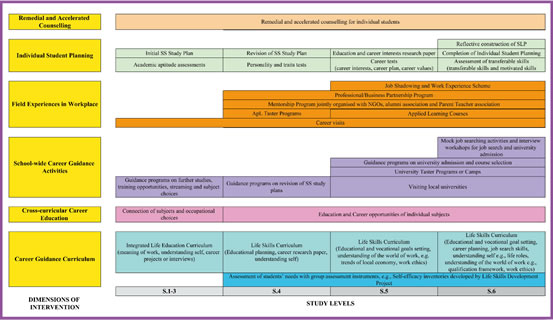
|
| |
| |
| Appendix II |
| |
Suggested Activities of Student Guidance and Learning on Future Study and Careers |
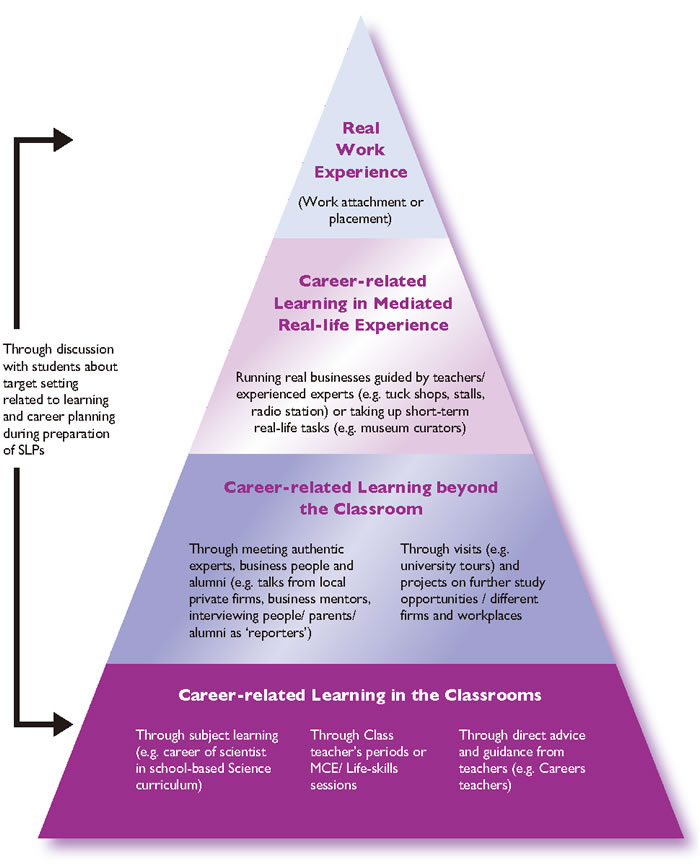 |
| |
| References |
| |
| Publications |
| |
| Bentley, T. (1998). Learning Beyond the Classroom: Education for a Changing World. London: Routledge. |
| |
| Curriculum Development Council. (2001). Learning to Learn: The Way Forward in Curriculum Development. Hong Kong: Curriculum Development Council. |
| |
| Curriculum Development Council. (2002). Basic Education Curriculum Guide – Building on Strengths (Primary 1 – Secondary 3). Hong Kong: Education Department. |
| |
| Department for Education and Skills. (2003). Careers Education and Guidance in England: A National Framework 11-19. London: DfES. |
| |
| Education and Manpower Bureau. (2006). Action for the Future – Career-oriented Studies and the New Senior Secondary Academic Structure for Special Schools. Hong Kong: Education and Manpower Bureau. |
| |
| Education Commission. (2000). Learning for Life, Learning through Life: Reform Proposals for the Education System in Hong Kong. Hong Kong: Education Commission. |
| |
| Foskett, N. & Hemsley-Brown, J. (2001). Choosing futures: young people’s decision-making in education, training and careers markets. London: Routledge Falmer. |
| |
| Handy, C. (1989). The Age of Unreason. London: Business Books Ltd. |
| |
| The Hong Kong Association of Careers Masters and Guidance Masters. (2008). Finding Your Colours of Life: NSS Subject Choices and the Development of Career Aspirations. Hong Kong: The Hong Kong Association of Careers Masters and Guidance Masters. |
| |
| Websites |
| |
EDB Careers Guidance website
(http://www.edb.gov.hk/index.aspx?nodeID=235&langno=1) |
| |
EDB CDI Career-related Experiences website
(http://cd1.edb.hkedcity.net/cd/lwl/CRE_WEB/index.htm) |
| |
| The Academic Programme Preference Inventory (APPI) developed by the Centre for Research in Distance & Adult Learning of The Open University of Hong Kong and the Hok Yau Club
(http://student.hk/appraisal/appi/?lang=c) |
| |
The Career Key
(http://www.careerkey.org) |
| |
The Hong Kong Association of Careers Masters and Guidance Masters website
(http://www.hkacmgm.org/) |
| |
The Hong Kong Federation of Youth Groups:
For employment
- Youth Employment Network:
(http://yen.hkfyg.org.hk/yen/lifebanking/lifebanking.php)
- Job Net青職網: (http://jobnet.u21.hk/)
For further studies
- U21.hk: (http://www.u21.hk/u21_2006/) |
| |
Quality Education Fund Cyber Resource Centre: “A Study on Secondary Students’ Career Orientation and Needs for Career Counseling” conducted by the Hong Kong Baptist University
(http://qcrc.qef.org.hk/qef/project.phtml?proposal_id=1998/2220) |
| |
|





